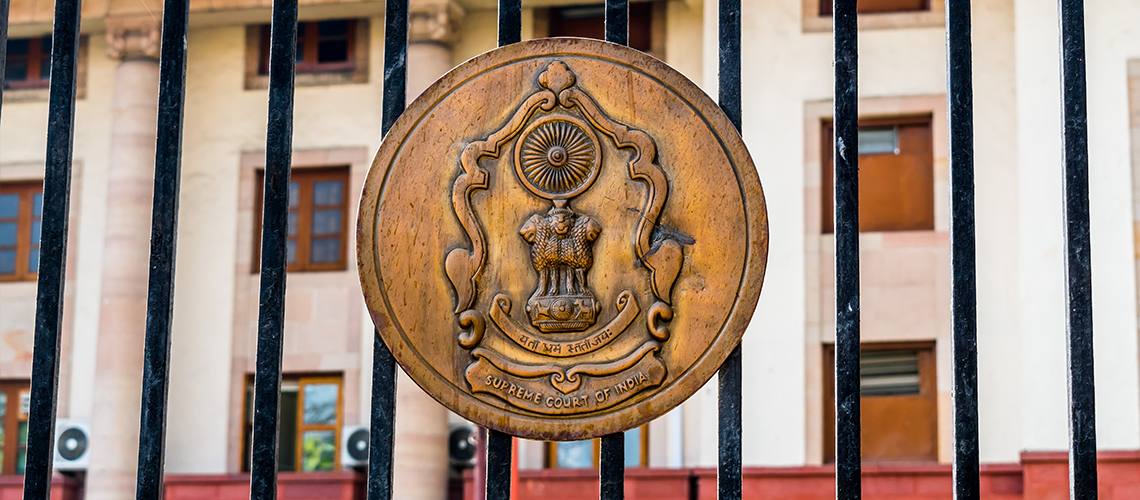Access to justice: Indian Supreme Court’s backlog is ‘serious issue’

A backlog of around 80,000 cases at India’s Supreme Court is impeding access to justice and, some commentators claim, weakening the country’s judiciary. ‘There is a problem. Delays are the elephant in the room,’ says Nusrat Hassan, Co-Chair of the IBA Asia Pacific Regional Forum’s India Working Group and Managing Partner at Dentons Link Legal in Mumbai. ‘Everybody is aware this is becoming a serious issue in the delivery of justice.’
The Supreme Court is made up of 34 judges, who are responsible for reviewing appeal cases, from employer-employee tribunals to land disputes, which have been escalated from district or high courts across India. The Court’s judges must also rule on any new hearings pertaining to the government.
While the Court’s caseload has always been substantial, over the years it has grown, according to research from the Centre for Social and Economic Progress in New Delhi. The caseload has expanded in line with increases in the population – there are now 1.4 million people in India, making it the world’s largest democracy – and their literacy level, as well as developments in the economy. The number of judges has not increased in line with this growth, however. ‘The [case] numbers are so large it almost seems impossible that we would be able to reach a point when we would be up-to-date,’ says Hassan. He adds that this means people accused of crimes are spending long stints in prison simply awaiting a trial.
It also means the judiciary is unable to operate effectively or fulfil its duty in holding the government to account, says William H J Hubbard, Deputy Dean at the University of Chicago Law School and a research professor at the American Bar Foundation. Ruling over routine cases takes time away from cases that might have implications for the government or society at large, says Hubbard, who’s co-author of a book entitled Court on Trial, A Data-Driven Account of the Supreme Court of India.
Related links
Delays are the elephant in the room. Everybody is aware this is becoming a serious issue in the delivery of justice
Nusrat Hassan
Co-Chair, IBA India Working Group
For example, when the government, led by Prime Minister Narendra Modi, wanted to implement Aadhaar, a national identification card scheme, it was challenged over privacy concerns. ‘The Court took so long to decide the case that by the time we got to the full hearing on the question of the legality […] the registry had already been implemented’, says Hubbard.
Delays are particularly common, says Tarun Khaitan, a professor of public law at the Law School of the London School of Economics and Founding Editor of the Indian Law Review and the Junior Faculty Forum for Indian Law Teachers, when cases demand an outcome that would go against the government.
The Supreme Court didn’t respond to Global Insight’s request for comment.
Writing in the University of Chicago Press’ Journal of Law and Economics, researchers Madhav S Aney, Shubhankar Dam and Giovanni Ko highlight that as judges approach retirement – which is set at the age of 65 for the Indian Supreme Court – there’s a greater chance that they’ll decide cases in favour of the government. That’s probably because ‘after retirement, the government is the single largest employer of former Supreme Court judges’, says Sital Kalantry, Founder of the RoundGlass India Center at Seattle University and co-author of Court on Trial. Institutional structures and rules make the Court ‘beholden to the party in power’, she adds.
But Nusrat believes there’s hope and that ’out-of-the-box’ thinking combined with increased investment into the infrastructure of the judiciary would help improve the status of the country overall. ‘The government needs to understand that some of the largest problems in our country would be solved if the judiciary was efficient,’ he says. ‘If you are able to close cases efficiently you’d bring down the levels of disputes, you’d end up promoting the commercial world substantially and you’d have less suffering.’
Hubbard, Kalantry and their co-author Aparna Chandra propose raising the retirement age of Supreme Court judges and that the Court takes a more selective approach to which cases can be admitted for its further review. ‘That would free up more time for scrutiny of cases involving constitutionality of legislation or the constitutionality of executive action’, says Hubbard. While he isn’t optimistic there will be reforms in terms of how the Court approaches the number of cases it hears and those that it chooses to spend time on, ‘there certainly are paths forward that I hope that the Court does pursue’, says Hubbard.
Ramesh Vaidyanathan, former Co-Chair of the IBA Asia Pacific Regional Forum and Managing Partner at Advaya Legal in Mumbai, says that by providing continuous education to lawyers, ‘more [would be gotten] out of the lower judiciary’, resulting in fewer appeals escalating to Supreme Court level. Khaitan believes that investment into skills, personnel and infrastructure would also help to improve a lower judiciary that’s currently ‘underfunded’ and ‘understaffed’.
The current Chief Justice, the Honourable Dr Justice Dhananjaya Yeshwant Chandrachud, has also been looking into the digitisation of courts, which could increase their capacity. Sandeep Bhupatiraju, a researcher specialising in data related to justice and law, is unsure of whether ‘having an app for everything means giving justice’, but ‘at the same time it adds a level of convenience’’.
Image credit: mrinal/AdobeStock.com